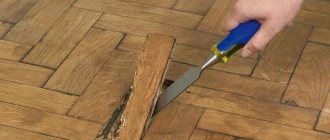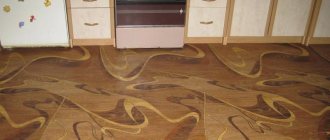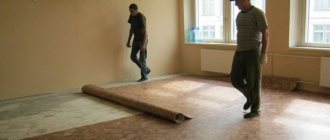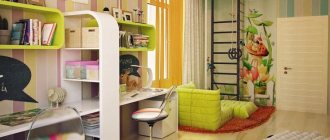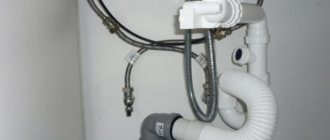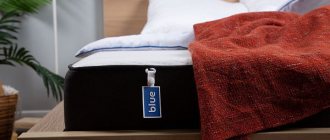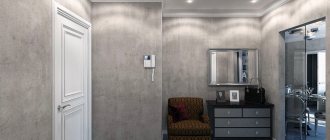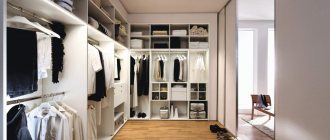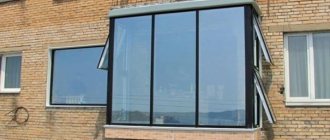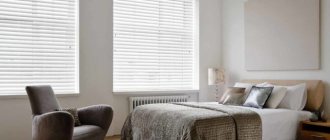During renovations, the question of floor finishing often arises. Expensive covering materials, such as cork, parquet or carpet, are not always affordable. The tiles make the room very cold and are only suitable for the bathroom and toilet. Laminate is afraid of water and can deteriorate if not used carefully. Unlike all of the listed types, linoleum has a moderate cost, retains heat, is moisture resistant and is designed for 25 years of service. A simple installation method allows you to do all the work yourself and save on installation. But what types of linoleum are there and what are their key characteristics? Understanding these details will help you choose the perfect coating for a specific room.
The best linoleum production companies
High-quality flooring products are produced by both domestic and foreign factories. If you don’t have time to research the features and differences of linoleum and just want to quickly purchase excellent products that will last for many years, then you should choose among the products of these manufacturers:
- Armstrong;
- Grabo;
- Juteks;
- Tarkett;
- Forbo.
But if you want to delve into not only the parameters of the material, but also get acquainted with specific models for various rooms, then you can read a detailed article on the best linoleum manufacturers.
Recommendations: 12 best linoleum collections
12 best mats for heated floors
9 best collections of solid wood boards
Structure and application of linoleum
Linoleum is widely known for its versatility for use in various institutions and private housing. This is a relatively cheap material that does not crack over time, and its installation is quick and easy.
Linoleum can be of different origins depending on the substances used in its creation, but most models have a similar structure of six layers:
- The basis. May be made of textile or foam. Responsible for the heat and sound insulation properties, as well as the flexibility of the fabric.
- Fiberglass. It adheres directly to the base and is responsible for the strength of the entire material. It can be reinforced or regular.
- The basis of printing. To apply a beautiful and clear design, you need a layer that will absorb the paint well and not allow it to spread.
- Surface embossing. It is performed on a printing layer and additionally adds expressiveness to the design.
- Protective layer. It can be made from various polymers and plays the main role in preventing abrasion of the pattern and the material itself.
- The last material that adds shine to the coating and serves as additional protection is a layer of PVC.
This multi-layer and inexpensive material can have different patterns and embossing, which allows you to reproduce the look of natural wood on its surface. An inexperienced user may even confuse it with parquet or laminate. The palette of shades makes it easy to choose a material for any interior.
The floor covering can be:
- without a base (in the form of several layers of basic substances) on which the applied pattern lasts for a long time;
- made of foam material, which provides high moisture resistance and flexibility;
- made of fabric, which ensures long service life and high quality.
A distinctive feature of linoleum is its resistance to moisture. The product base does not contain absorbent layers that are susceptible to swelling, and reliable protective coatings completely eliminate this possibility. Thanks to these properties, it is an indispensable material for kitchens, baths, and corridors with high traffic and frequent wet cleaning. Linoleum is made in different thicknesses, which provides high heat retention and sound insulation. This allows you to lay it in children's rooms and schools.
The popularity of linoleum is also due to its simple installation, which saves the family money. The rolls are rolled out and cut to fit the size of the room. After giving them time to straighten out a little, the floor is prepared: debris is removed, cracks are sealed and the baseboard is dismantled. After which installation and fastening are carried out. This could be adhesive in the case of concrete floors or nails and strips for wood base(s). The final stage is cutting off excess areas and fixing the plinth.
Linoleum in a country house
You will be able to find a selection of designs and tastefully chosen colors for the kitchen. In addition, if glassware falls on a linoleum floor, the chances that it will remain intact are much greater than, for example, if it were a ceramic tile floor. However, it is not recommended to place hot dishes on even the most durable linoleum - most likely, it will leave a brown or black stain that cannot always be cleaned.
Linoleum can also be applied to heated floors as long as they do not heat up above 27 degrees.
Imitation linoleum boards or natural linoleum, which is more environmentally friendly and more vibrant, will create a feeling of coziness and warmth in children's rooms, living rooms or bedrooms. People with allergies also tolerate it well.
Linoleum in the interior of the hall
Faux wood planks are also a good solution if you really need hardwood floors in your living room. Linoleum slabs come in different thicknesses and strengths, and their colors and shades vary. If the house is not heated regularly or there are no heated floors, a linoleum floor will be warmer than, for example, a stone tile floor. However, linoleum can also be present on heated floors, as long as they do not heat up above 27 degrees. If there are no complaints about imitation, stone or other textures, linoleum tiles will look great in the bathroom, kitchen and veranda. For a more original look, linoleum can be combined with soft flooring, carpets, real tiles and wood floors, as well as other types of linoleum.
Types of linoleum
Manufacturers produce many types of linoleum, differing not only in design and color, but also in the substances involved in its production. This affects the use of the material and its cost.
Natural linoleum
Excellent material made from natural ingredients costs good money. This is exactly what the flooring known as natural linoleum is. Since the demand for it is not so great, it is more difficult to find such products on sale. This material will be an ideal solution for allergy sufferers and asthmatics, since natural substances will not irritate the mucous membranes and respiratory organs.
Natural linoleum is made from jute fabric as a base. The filling layers are wood and cork flour. The binding component is pine resin, and it is painted with limestone powder and natural pigments.
Advantages:
- environmentally friendly;
- many colors;
- durable outer layer;
- easy to care for;
- does not deform from heat and ultraviolet radiation;
- not subject to combustion (if you drop a burning match in the kitchen, there will be no trace);
- prevents bacteria from forming underneath.
Flaws:
- Expensive;
- It is not advisable to use in rooms with constant splashes;
- may break when thrown in a warehouse;
- brittle when bent, which requires very careful installation.
PVC linoleum
Belongs to the most common types. Has a textile or foam base. Can be produced in a wide range of thicknesses. The outer layer of polymer film protects the pattern and texture well from abrasion. The material has a large selection of colors and an affordable price. Suitable for children's rooms, bedrooms, office corridors, hospitals, schools and other institutions.
Advantages:
- does not transmit cold from concrete to the room;
- very simple installation technology;
- does not accumulate electricity and does not attract small debris;
- large selection of colors, patterns and sizes;
- environmentally friendly;
- the material does not rot in wet conditions and is designed for 15-20 years of operation;
- affordable price.
Flaws:
- may be deformed from high temperatures;
- when chemicals enter, traces remain;
- on cold floors it loses elasticity and cracks are possible;
- Over time, it diverges at the joints due to contraction of the internal structure.
PVC linoleum is called synthetic and is divided into three categories of use. The household segment of products is cheap, has a short service life (5-10 years) and is not very thick. Semi-commercial options are used in public buildings with low traffic and are designed for 10-20 years. It is often purchased for apartments. Commercial products are distinguished by their high cost and durability. A thick layer and additional protective coatings allow it to be laid in offices and work areas.
Additional types of linoleum
In addition to the main two types, there are additional types of linoleum with specific components, but finding them on sale is much more difficult. One of them is relin. The rubber-like material is well suited for wet conditions (gym locker rooms with showers, bathtubs, toilets). The product has two layers: hard on the bottom (bitumen) and smooth with a tint on top. The advantage is water resistance and flexibility, but the disadvantage is the presence of volatile substances with an unpleasant odor.
Glyphthalic linoleum has a fabric base and a filler with dyes. Its binder component is alkyd resin. The product has a durable pattern and thermal insulation. Perfectly smooths out vibrations. One of the disadvantages is that it breaks quickly at bends, which complicates installation. Great for a children's room.
The colloxylin product combines nitrocellulose and dye. It has no base, therefore it is much thinner than its analogues. It is resistant to water, has a shiny surface and is flexible, but when the temperature changes, it tends to deform and shrink over time. Can only be used in private housing, for example, in a bedroom.
Natural material also has disadvantages. Let's list them:
- high price, which can be compared with the price of parquet boards;
- the material is afraid of moisture: the natural base can begin to rot when exposed to moisture;
- the material has low elasticity, which makes it difficult to install in a cold room or at low temperatures;
- the specifics of manufacturing do not allow the production of products of any ornaments and colors - their range is limited;
- A freshly laid coating made of such material has a smell that not everyone likes. It will disappear only after a few months.
For adherents of natural materials and eco-friendly housing who are willing to put up with high costs, this will probably be the best linoleum for the home.
PVC linoleum (polyvinchloride)
The international designation of this material is PVC. It has been actively used in different countries for a long time, and is available in different forms - with and without a base. The first is divided into subtypes, depending on the type of base itself.
It happens:
- Fabric . Its role can be played by the natural material jute, but often it is also a synthetic fabric, such as fiberglass. The upper part with the pattern is made of polyvinyl chloride. The thickness of this material is up to half a centimeter.
- Non-woven - made from artificial materials or natural felt. Helps improve the thermal insulation qualities of the material. It is not very resistant to high loads, so it is not recommended to lay it in high traffic areas. The porous base is able to absorb moisture.
- Foamed PVC . A type of coating with such a base began to be produced at the end of the last century. This type of foundation is considered one of the most popular. The porous PVC layer acts as a shock absorber, softening loads and smoothing out minor irregularities. The use of reinforcement keeps the geometric shape and dimensions of the canvas unchanged. Foamed polyvinyl chloride is applied in two ways - mechanical and chemical. The first is more progressive; its use allows products to withstand loads without creasing.
A material is also produced that combines several different layers from those listed.
Heterogeneous linoleum
Linoleum, which contains layers of different types, is called heterogeneous. The one that consists of one of them is homogeneous.
What is characteristic of a homogeneous material?
Its special quality, which is also an advantage, is the presence of the pattern throughout its entire depth.
This means that, with the inevitable wear of the material, the pattern on it will remain unchanged.
It has a thickness of up to three millimeters and is usually laid in rooms with high traffic. It is not advisable to purchase it for home use. The disadvantage is the high cost, as well as the fact that it is impossible to apply a complex pattern to the material.
Polyvinyl chloride linoleum has a number of advantages that ensure its demand and widespread use:
- Elasticity, simplifying the installation process of the material.
- Budget cost.
- The variety of PVC textures and patterns allows you to realize the most daring design idea.
- Easy to clean and wash.
- Products from trusted manufacturers have safety certificates and cannot cause harm to health.
Disadvantages of PVC linoleum - when it is heated strongly, it may shrink. Immediately after installation, a specific smell appears in the room, which disappears after a while.
Alkyd linoleum
Alkyd linoleum
This is a wonderful modern material that is popular. When laying it, you should follow certain simple rules. Such material may undergo deformation even before flooring. To avoid installation errors, it should remain in a warm room for some time. The most common defect is a change in the proportions of the coating: having significantly decreased in width, it can noticeably increase in length.
Another name for the material is glypthal. It always has a fabric base, on top of which glypthal or alkyd resins are applied using special technology. The fillers included in their composition (resins) significantly improve the performance of the coating. The addition of dyes and pigments affects the color of the pigment, making it colored or uniform.
Obvious advantages of alkyd linoleum:
- better sound and heat insulation properties than PVC;
- extremely high wear resistance, service life can be up to 50 years;
- Dirt from the surface is even easier to remove than from PVC linoleum;
Disadvantages of such linoleums:
- In fact, there is no elasticity at low t;
- They only need professional styling, otherwise the result is not guaranteed.
- Low fire resistance rates limit their residential use.
But the material is actively used in transport. It is used to make flooring in the cabins of ships, as well as flooring in train carriages and airplanes.
Relin, or rubber linoleum
This type of linoleum is made of two layers: the top one is made of colored synthetic rubber, the bottom one is made of recycled rubber. These two layers are connected by viscous bitumen mastic.
These types of linoleums have a number of advantages:
- Ultra-high moisture resistance makes it possible to use it even in extremely damp rooms.
- Excellent strength and elasticity.
- Remarkable anti-slip properties.
- Long service life.
Such rubber coatings are widely used in swimming pools, gyms, workshops and garages. Their use in residential premises is prohibited due to the harmful substances they emit.
Colloxylin (nitrocellulose) linoleum
This is a single-layer coating without a base, which is made from nitrocellulose with the addition of gypsum, plasticizers, red lead and dyes.
Currently, such coatings are not used due to their high fire hazard.
For an apartment or a house: which linoleum is better?
So much information on the types of floor coverings at once can only complicate the choice: which quality linoleum is better for the home. In addition, the overwhelming majority of modern materials are heterogeneous, and usually combine several different layers.
For this reason, Western manufacturers have developed a special standardization that divides all linoleum floor coverings depending on their purpose and strength qualities.
It divides linoleum into classes, each of which is designated by a special two-digit code of numbers and a pictogram.
The first of these numbers indicates the scope (for what types of premises) of the products:
2 – residential;
3 – commercial or office;
4 – production.
The following figure explains the permissible degree of load that the product can withstand:
1 – low;
2 – average degree;
3 – high;
4 – extremely high.
Household linoleum: which one to choose?
Household linoleum belongs to classes 21-23.
According to the European standard, it must have the following operational and performance qualities:
- Thickness from 0.15 to 3 millimeters.
- Weight 1.25 - 2.25 kg per square meter.
- It must have such elasticity and flexibility that it does not break or crack when wound on a standard rod d 45 mm.
- The water absorption rate is no more than 1.5%.
- Sound insulation indicators – from 13-18 dB.
- Shrinkage during use should not exceed 0.2 mm per meter.
Semi-commercial linoleum
This is linoleum from 31 to 34 classes, which is usually used in typical office spaces and service areas.
It has the following characteristics:
- Specific gravity from 1.6 to 2.5 kg per square meter.
- Flexibility and elasticity should allow it to be wound onto a rod with d from 10 to 40 mm without damage.
- Shrinkage during use is no more than 0.1 mm per meter.
- The sound absorption rate is from 12-16 dB.
- Operated from 7 to 20 years.
It is advisable to use such a semi-commercial coating as a household coating in places with increased load - hallway, kitchen, etc.
Commercial linoleum
Belongs to classes 41-43. It is used as a floor covering in rooms where the floor bears a particularly high load, and where there is active movement of people and even equipment. It is equipped with a special reinforcing layer, has minimal shrinkage, and has a service life of up to 25 years. The combination of the high price of such material with technical characteristics that are not required for ordinary residential apartments makes its use at home impractical.
Individual linoleums of this group are produced for a special purpose, these are:
- Sports coverings. They are characterized by special elasticity and softness, which provide excellent adhesion of the floor surface to shoes.
- Antistatic coatings.
- Coatings that are resistant to chemicals and have high bactericidal properties. Designed for various medical institutions.
- Anti-slip coatings. Used in swimming pools and other rooms characterized by high levels of humidity.
How to choose linoleum?
We examined in detail the different types and types of linoleum. Based on their description, we have identified those important conditions, guided by which, it will be easier for you to choose the most suitable material for the floor in your home.
- It is advisable to purchase flooring exclusively in specialized departments and stores. The products there have all the required certificates and accompanying documents; stored in strict accordance with rules and regulations.
- You should pay attention not only to the tone and pattern of linoleum, but also to its density, thickness and the presence of a protective film.
- The material class is selected according to its purpose. You can choose linoleum with a certain margin, that is, a class higher than required, but not lower.
- It is advisable to purchase material according to the width of your rooms. If the material is the same, then the coating will not have unnecessary connecting seams.
- In rooms where the nature of operation requires a high degree of pollution, it is advisable to use glossy materials.
Characteristic signs of high-quality linoleum are the absence of a strong odor, greasy shine, but the presence of relief. The drawing in the original high-quality coating looks natural and clear. A one and a half meter pattern step is considered the most preferable. Manufacturers of flooring always put a special corporate logo on their products. Also, high-class linoleum should have at least five layers.
Linoleum selection options
Despite the wide variety of materials used in the manufacture of linoleum, there are many parameters inherent in all types of this product. By understanding these features, you can quickly decide on the choice of flooring for specific conditions.
Type of base used
Baseless linoleum options are quite thin, which reduces their insulating properties. But the pattern permeates the entire thickness of the product. Therefore, erasing the top layer will not lead to empty spaces in the part of the coating that is most walked on. Therefore, this product should be used in public places with low traffic (offices, offices). It is also suitable for a living room in an apartment.
Foamed polyurethane provides a high layer and good heat retention. Moderate flexibility makes installation easier. This type of linoleum is suitable for most children's rooms, kitchens and bedrooms. The fabric base will allow the material to be used for a long time, which is applicable in schools and hospitals with high traffic. This type is also used in industrial workshops and factories where there are no hard cutting objects in circulation. Workers have a warm covering under their feet that remains intact and beautiful for a long time.
Material thickness
Linoleum can be of various thicknesses from 1.1 to 3.2 mm. The insulating properties and comfort when walking barefoot depend on this. Therefore, in a children's room, where there will be a lot of noise and a warm floor is needed, a maximum thickness of 2.8-3.2 mm is suitable. The same thickness indicator should be chosen in the case of high-traffic areas, and for an office a layer of material of 1.2 - 1.6 mm will be sufficient.
Wear resistance
This parameter indicates the service life of the coating. The thicker the protective layer, the longer the integrity of the pattern and uniformity of color will be maintained, regardless of the number of people passing through the material per day. The protective layer is indicated in mm and can vary from 0.15 to 0.8 mm. For a private house or apartment, a value of 0.2-0.3 mm is sufficient (in the hallway and kitchen) and 0.15 mm for the bedroom, but for educational institutions a value of 0.4-0.5 mm is required.
Moisture resistance
This parameter is not prescribed separately, but the characteristics of the material are clear from the substances in its composition. For the kitchen and bath, where the highest humidity is present, all types of PVC linoleum, as well as Relin with a two-layer structure, are suitable. Fabric types and baseless ones are best laid in dry rooms (bedroom, offices).
Roll width
Regardless of the chosen type of linoleum, you should pay attention to the availability of the roll width corresponding to the parameters of the room. If the room has an area of 3 x 4 m, then you should look for options for rolls with a width of 3 or 4 m. This will allow you to lay a continuous sheet. Otherwise, joints will be required, which may diverge over time. Rolls come in lengths of 2.5-4 meters, but possible intermediate options depend on the specific type of product.
Classification and labeling
The product always indicates two values: the first number is the purpose of the premises, and the second is the traffic class. Room indicators 1-2 are suitable for living rooms, and numbers 3-4 should be sought for installation in office and industrial buildings. The cross-country ability class combines many factors and forms a single maximum indicator. For example, for a bedroom, 21 class coatings are enough, but for the kitchen it is worth buying 23 class. The highest this value can be is 32.
Drawing and quality
Although everyone chooses the color and pattern options to their own taste and in accordance with the existing design in the room, it is worth paying attention to the quality of finishing of the flooring material. You should not buy rolls with the same article number from different batches, this is fraught with mismatched shades. When inspecting a roll upon purchase, you need to unroll it and examine it for air bubbles, pores and tubercles. All this indicates a poor quality manufacturing process.
The color on the surface should be uniform without visible differences. Scuffs in a new roll are an indicator of a thin protective film. The pattern on high-quality linoleum has the same clarity and shape.
Additional selection criteria
Although most linoleums have their own specific smell, it should not be so strong that it is impossible to stay in the room. You can check this only by inspecting the product in person, and not on the Internet. Another factor is the flammability of the material. In the event of a fire, ignited floors can cut off the path to the only exit. Even during melting, substances toxic to breathing will be released, so it is worth buying products with class G1 or G2 for residential and public places. For low-traffic areas, a lower class G4 is also suitable.
Photos of examples of the interior of a room with linoleum
Based on the recommendations in this article, choose which linoleum is best for your room, and photos and examples will help you decide.
Flooring for laminate panels will be a worthy decoration for any interior.
Linoleum for parquet completely copies the appearance of a parquet board
Linoleum in the living room is most often chosen in warm tones, which create coziness; the cold color of the floor gives a strict look.
Natural stone linoleum can imitate marble, granite, sandstone or quartzite
A beautiful large pattern in the center of the room is worth choosing if you do not plan to cover the floor with carpet.
Covering with flowers will fill the space with new colors and a festive atmosphere
A striking element of the hall design can be an imitation of green grass
Bleached oak increases the illumination of the room and is harmonious in combination with dark furniture.
This coating will highlight pieces of furniture favorably
In a house where a pet lives, it is advisable to have a coating with antistatic properties to prevent hair from collecting. When choosing which linoleum is best for the hall based on the photo, take into account your furnishings and the area of the room.
A coating that imitates crocodile skin will be very original.
Linoleum with photo printing looks incredibly beautiful
Imitation of valuable wood always looks rich and stylish
If desired, you can choose linoleum with imitation ceramic coating
Linoleum is an affordable competitor to laminate and parquet, which fits well into the interior and is not inferior to expensive materials in terms of service life. The range of this material is extensive, so before purchasing, determine what requirements you place on the product: composition, thickness, appearance, body and sound insulation, bactericidal and antistatic properties. The price and quality of the material depend on these indicators.
Which linoleum to choose
Having systematized most of the characteristics of these products, we can highlight the main indicators for the specific use of linoleum:
1. Baseless material of class 21 with level 1 permeability is suitable for personal offices and living rooms.
2. For kitchens and bathrooms you will need PVC with the third level and class 24 or two-layer relin.
3. Children's and bedrooms need a foam base and a layer of 3 mm. Class 22 and level 2 will be enough.
4. Schools and hospitals, as well as office corridors, should be equipped with fabric types of bases with class 24 and level 4. The thickness required is 3.2 mm.
5. For allergy sufferers and children's camps with permanent residence, only natural linoleum is suitable.
How much does linoleum cost?
The price of this floor covering depends on the substances used in production and the parameters of thickness and wear resistance. For common types of premises, linoleum will have the following price range:
- Natural material for asthmatics costs 1000-1900 rubles/m2.
- For a personal office or hall, covering will cost 240-350 rubles per 1 square meter.
- For a children's room and bedroom the price is 400-580 rubles/m2.
- For the bathroom and kitchen you will need to buy material for 450-600 rubles/m2.
- Premises with high traffic require a wear-resistant coating, which costs 580-680 rubles/m2.
Types of linoleum
Linoleum has a broad classification according to a large number of characteristics. The main one is the material of manufacture. The coating can be natural or artificial.
- Models made from natural materials are extremely expensive and are therefore rarely used. They are made from hemp, jute or flax, and other components are added to the composition.
- The choice of artificial linoleum is huge. There are variations made from PVC, rubber, and there are glyphthalic and colloxylin products. To have an idea about each of them, it is worth studying the characteristics in more detail.
